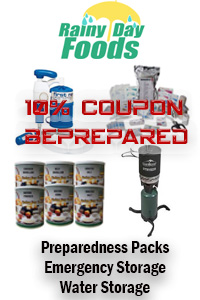Prepping doesn’t have to be an individual responsibility, it can (and should be) a shared experience which involves the entire family. Of course one has to go about it the right way if considering how to involve the kids, no 7 year old wants to be handed a 4 page spreadsheet with the instructions: “go conduct an inventory of the entire food storage room and rotate items as necessary.” Similarly while one spouse might enjoy the thrill of all things survival and prepardness the other might be less than enthusiastic, so finding ways to break the ice in order to get them involved (and engaged) can be tricky. Whatever your method might be the end goal should be the same, finding a way to get everyone involved while making the process enjoyable. Here are a few suggestions on how to achieve that goal.
1. Label turning at the store. I made this a fun game with my daughter when out shopping for groceries. We would try to find items that had the longest expiration date, depending on what section we were in. She would always be so proud to find something that had a 2 to 3 year expiration date, “hey dad look at this can of beans, it doesn’t expire until 2015!”
2. Altoids survival kits. I recently made one of these kits, and really there is no rule that says you have to use an Altoids tin either. Obviously not for small children (unless they are supervised) but if you have a few kids you could challenge them to come up with their own version of a survival kit based on what is lying around the house.
3. Inventories. While not high on the “most fun ever” list inventories still need to be conducted. It’s a great way to involve everyone and to ensure that everyone knows the scope and location of the preps in your home. This way if you ask little Johnny to grab a can of beans from the shelf he will know exactly where to go, and which can to grab (based on shelf life rotation).
4. Television. There are some shows out there that the entire family can watch together, Doomsday Preppers and Doomsday Bunkers being a couple of the most popular. During commercial breaks or after the show you could conduct a critique of what was shown, what everyone liked and what they thought could be improved.
5. Tracking hygiene supplies. How many rolls of TP does your family use in a month? How long will a tube of toothpaste last in your home? Assign one of the kids to track the usage of your hygiene items, every time a roll of TP is changed out it gets annotated. By assigning responsibility and telling that person how important it is you make them feel like they are truly helping the family out (which they are).
6. Construct a bugout bag. This one can be a fun one because it’s more than just stuffing things into pockets. This is an opportunity to discuss what each item is, why it is important and also why it deserves a place in the bag (versus other less important items). Each person in the home should have their own Bugout Bag which creates a great opportunity for them to utilize a little of their own creativity.
7. Use that wheat grinder. Experiment a little bit with that wheat grinder you bought but have never used, I’m pretty sure all of those #10 cans of winter wheat that came with your year’s supply of food won’t miss one can if you break it open. Grind up some winter wheat and have a hardtack baking contest, see who can make the least edible out of the bunch (your initial results may be pretty terrible). By experimenting you learn what not to do if the time ever comes when you can’t afford to waste any precious food.
8. Assign responsibilities. In one recent article I wrote about how to organize a survival community by assigning various responsibilities (medical, communications, security etc). The same could be done on a much smaller level at home, putting someone in charge of certain parts of your prepping plan. For example in my house my wife is in charge of all of the medical supplies. One of my daughter’s responsibilities is maintaining all of our communications equipment.
9. Learn a new skill. Often overlooked are the skills involved in a good survival / prepping strategy. I’m not saying that you should send your wife off to learn how to become a blacksmith, or one of the kids to a welding academy on the weekends. Rather keep it simple, like learning how to make fire without matches or training how to tie certain knots with rope. These are skills that are very important but can still be done out on the back patio during an evening after work.
10. Shooting. Last but certainly not least, get the family involved in all aspects of shooting. Firearms safety should always be paramount for new shooters and the more training each person gets the less likely they are to be tentative around guns. Safety training, shooting drills and learning how to properly clean guns can be a family event. I believe the best way to train kids about guns is to educate them about how serious they are and what great responsibility is involved for those who own them. This versus hiding a gun in the closet and hoping that little Johnny never finds it (he will).









2 comments
Just me and the Mrs. She is fully on board with our efforts (maybe even more than me). She really likes to find new ways to use food storage products. Learning to prepare them now without the use of modern conveniences is important to be successful if /when the S*** hits.
Author
My wife isn’t a big fan of the food storage products, but I figure she’ll get used to them soon enough. Not like she has a choice in the matter…